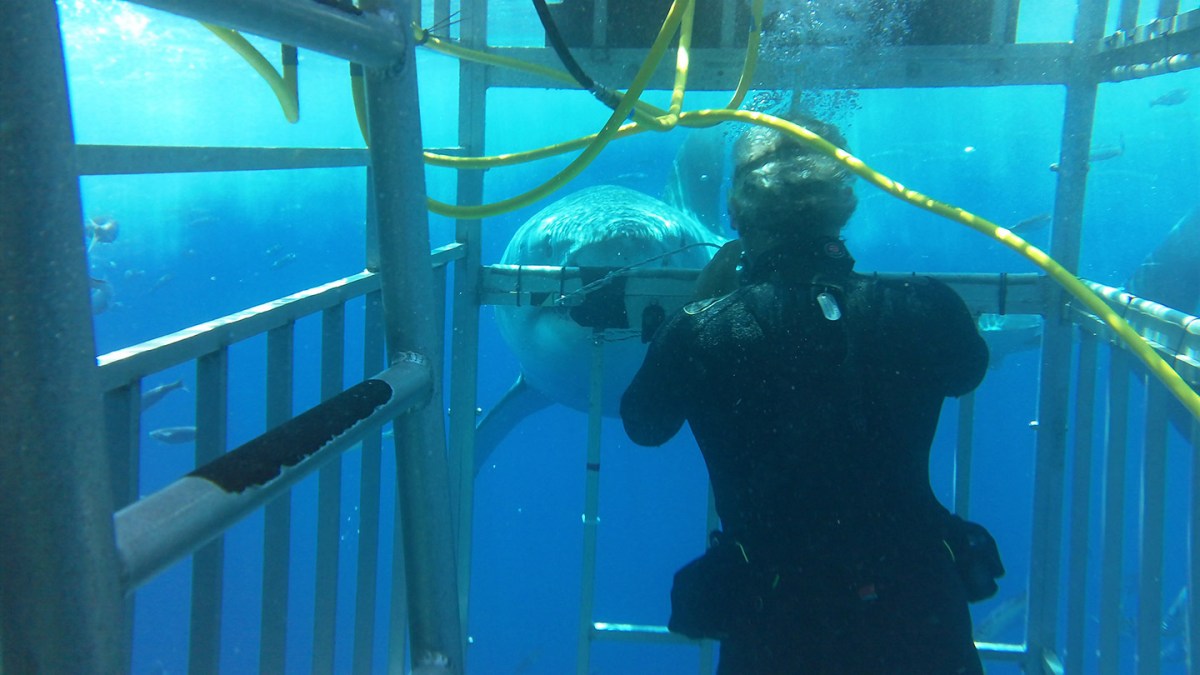The water is warm. The days are long. And it’s time for the summer pop-culture phenomenon known as Shark Week to take you deep … into your couch.
Discovery Channel’s mega hit has been around since 1988 and runs the gamut from programming dedicated to conservation efforts and correcting misconceptions about sharks to the ridiculous fictional programming that one can genuinely say “jumped the shark.” It’s a roller coaster ride of emotions for audiences, shark conservationists and marine biologists who like the sweet taste of spotlighting fascinating animals yet recoil at the bitter aftertaste of media sensationalized programing that sometimes crosses the line into the absurd. This year the highlight was a race between Michael Phelps and a fake great white shark.
I get the appeal. I really do. Sharks are awesome. Which is why I’ll spend my Shark Week actually in the water with them. The great news is you can too. You can be planning your own encounter with the shark that Peter Benchley, screenwriter of Jaws, brought to life and then ultimately catastrophic death … on and off screen, the great white.
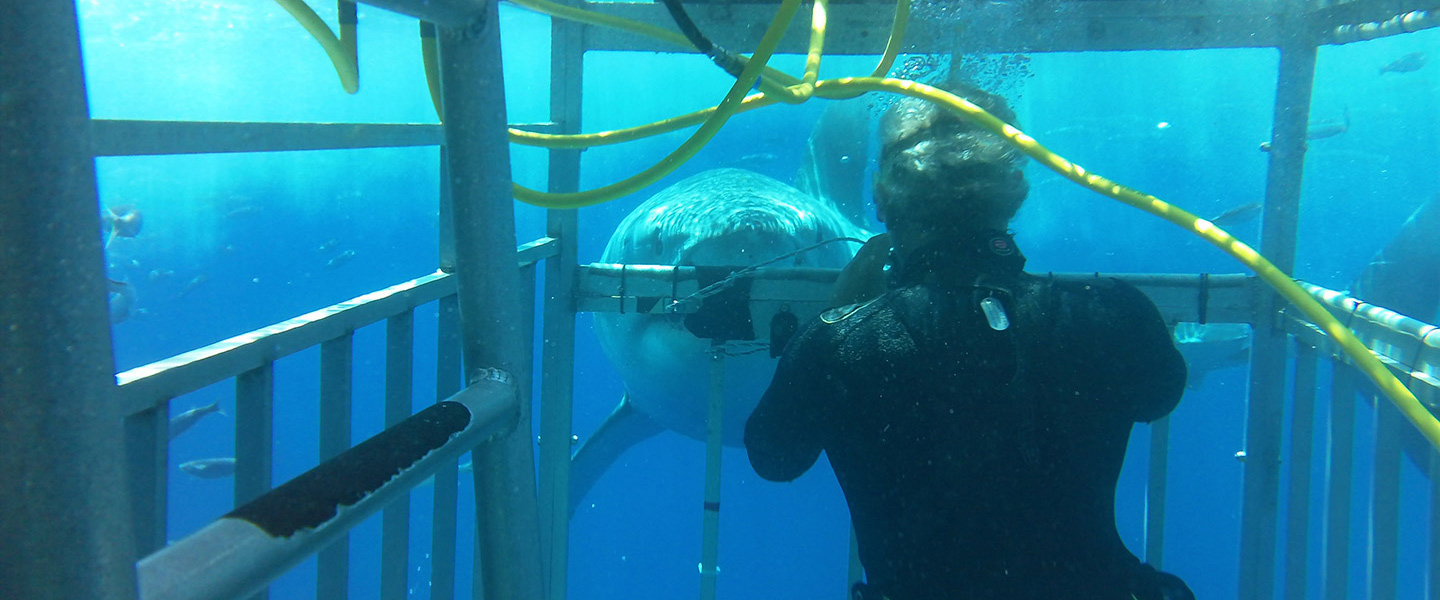
If you want to get up close and personal with white sharks, your best bets are South Africa, Australia and Mexico. Guadalupe Island, Mexico tends to be the bar none favorite for conditions and abundance of sharks.
“Whhhiiitttteeeee Shark!” Two words most people hope to never hear for fear they might be their last. Certainly not verbiage that ever becomes background noise. But when you venture by boat 150 miles off the coast of Mexico to Guadalupe Island, a geological wonder, a biosphere reserve and one of the world’s premier sites to cage dive with great white sharks … things are a bit different. If you’ve come this far, you’re here to see them. Those much-maligned wonders of nature that instill as much awe as they do fear.
The trip is a five-day live aboard with a price tag of $3,195.00 including food, drinks, an on board shark expert, gear…and guaranteed shark encounters. Shark Diver, the outfitter I’ve been going with since 2012, leaves out of San Diego and, after a brief stop with Mexican border patrol in Ensenada, spends 18 hours on the open ocean getting to the island. If you’re prone to seasickness, Dramamine is your best friend. The onboard accommodations are modest bunks, but just right for this adventure and you’ll spend most of your time in the galley or enjoying the outside decks anyway. Massive schools of spinner dolphins and an occasional whale have been our icing on the cake on most crossings.
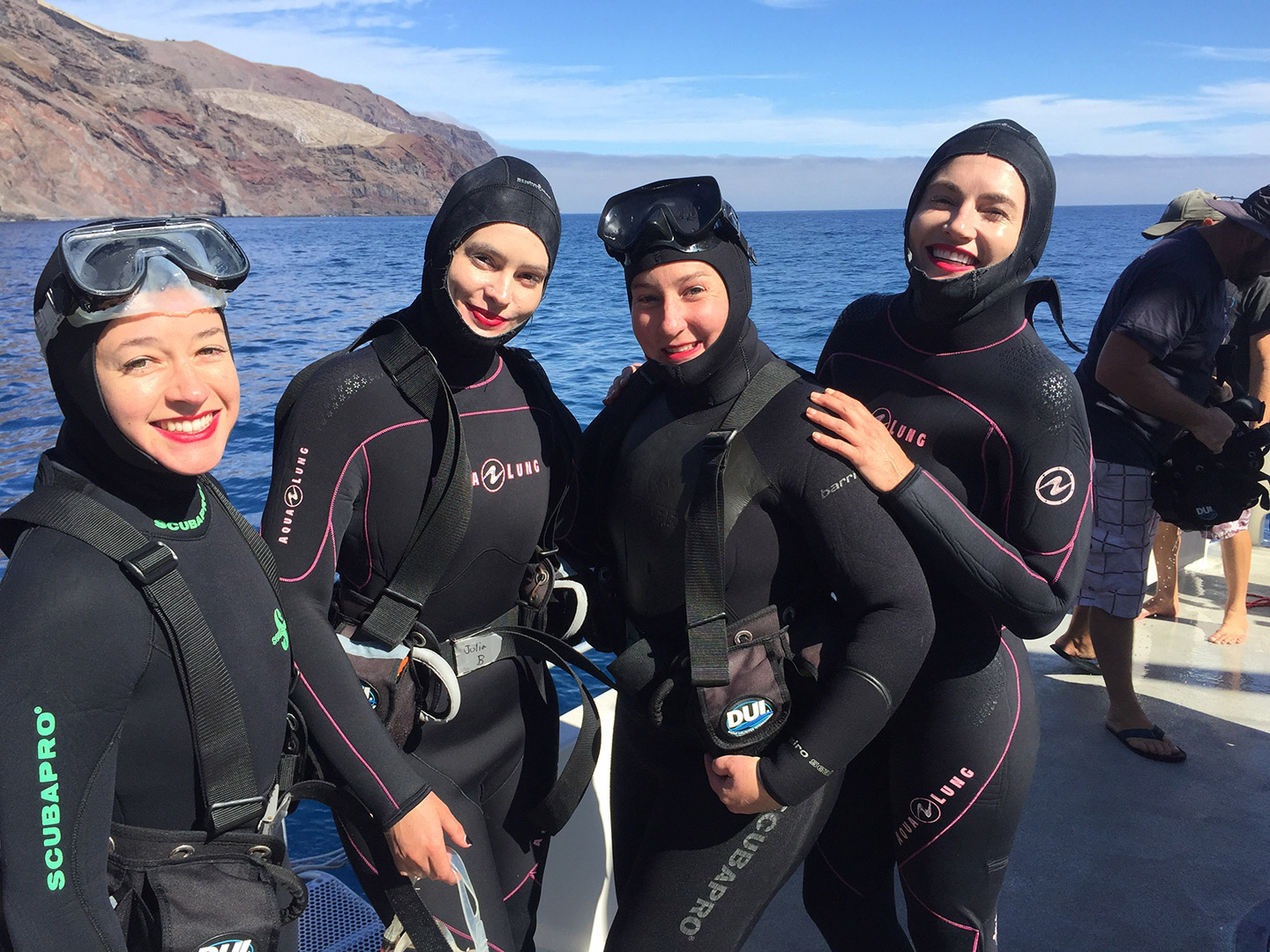
Onboard are a maximum of 16 shark hungry excursionists eager to see yet another massive gray shape cruise the boat, a fin breaks the water–or best of all–a big guy go for the bait and show off his or her three-inch pearly whites.
The highlight of the trip is spending cage time face to face with one of nature’s most incredible examples of the perfect predatory form. So perfect evolution took one look at her design roughly 100 million years ago, dropped the mic and walked away.
Cage diving with great whites is part of the ever growing shark ecotourism industry that is raking in a whopping 300 million dollars a year world wide. It’s a game changer for sharks. 80-100 million are killed every year for their fins, cartilage and as by catch. That’s bad news for the oceans and for us. But with more and more people wanting to see sharks alive, there’s a chance to redeem the damage. It’s also an incredible opportunity to encourage communities that once made a living selling shark parts, mostly to the Asian market, to protect the animals as a source of revenue from tourists wanting to see them thriving.
Sort of like a serrated tooth, the debate over shark ecotourism is biting.
On one hand, you have the naysayers who believe we should only take a Cinema Verite approach to wildlife interactions. To only experience animals in the fleeting glimpses where they make manifest in their natural habitat or not at all. That we rather tell our children tales of magnificent beasts than take them for close encounters in even slightly altered environments.
On the other side of the spectrum, yaysayers believe there is incredible value in orchestrating responsible interactions with animals in wild habitats and letting the sense of wonder root itself in people who then understand the value of conservation and, having made a personal connection, feel more ownership over these creatures. There is definitely something to be said for all five of your senses being engaged to maximum spine tingling capacity when in the space of genuine honest to goodness first-hand experience of the marvelous.
The demographic for shark tourism is an interesting cornucopia of the human condition. I’ve seen it all. Rich playboys looking for a thrill. A 70-year-old nurse who read an article on the feeling of awe and wanted to experience it for herself. Families committed to giving their kids a kick ass perspective of life on this planet. Bucket listers. Those wanting to overcome their fears. Spouses getting dragged along for the ride. Divorcees searching for something more unique than Vegas to let off steam. Whatever universal kismet brought them there, without fail, they all get out of that cage changed. Some cry, some hoot and holler, some stand in awestruck silence dripping salt water as if they had just been baptized. And in a sense they have. They stumble back onto the deck, wander off in their wetsuits and take a moment to absorb the surge of feelings that can’t quite be put into words without primal expressions. You’ll feel it too
Personally, I believe the answer on shark ecotourism, like most things, is found somewhere on that tight wire act we call the perfect balance. Being well informed is key. Choosing wisely is paramount when it comes to outfitters. I have spent years and many adventures partaking in activities that bring me near wildlife, most frequently sharks, which is how I first set foot aboard Shark Diver’s great white expedition five years ago.
Of the several outfitters who run trips to Guadalupe, the Shark Diver team has an impeccable safety and environmental record. They are not shark cowboys pushing the envelope for a bigger rush. There’s no need. They groan when they see videos of sharks “jumping” into cages. Mostly because the shark didn’t jump in. The bait handler pulled the attractant in the direction of the cage and the shark, not having breaks, went right after it. The media usually takes it from there.
Shark Diver has savoir-faire. They pride themselves on participating in a variety of scientific studies that aid conservation efforts. Photos of the sharks are gathered after each dive and handed over to the Marine Conservation Science Institute where they keep a photo database of Guadalupe’s sharks. Several of their crew, even their deck hands, have degrees in biology and wildlife management. Captain Cary was a scientific support diver for NOAA at an underwater habitat and then employed at Scripps Institute of Oceanography before helming the 80-foot MV Horizon. Needless to say, you’re in good hands and so are the sharks.
On the second morning of the trip, you wake up at Guadalupe Island and lay in your bunk for a freeze frame of time recognizing that below the wooden hull of the boat big sharks are swimming in the mint blue water. This is the perfect moment for a cool existential moment before grabbing a mug of coffee and heading on deck to see a brilliant fire red sunrise accentuate the already dramatic outline of Guadalupe and the crew lowering massive steel enclosures into the water. A hearty breakfast is served in the galley and the first team gets deployed into the abyss.
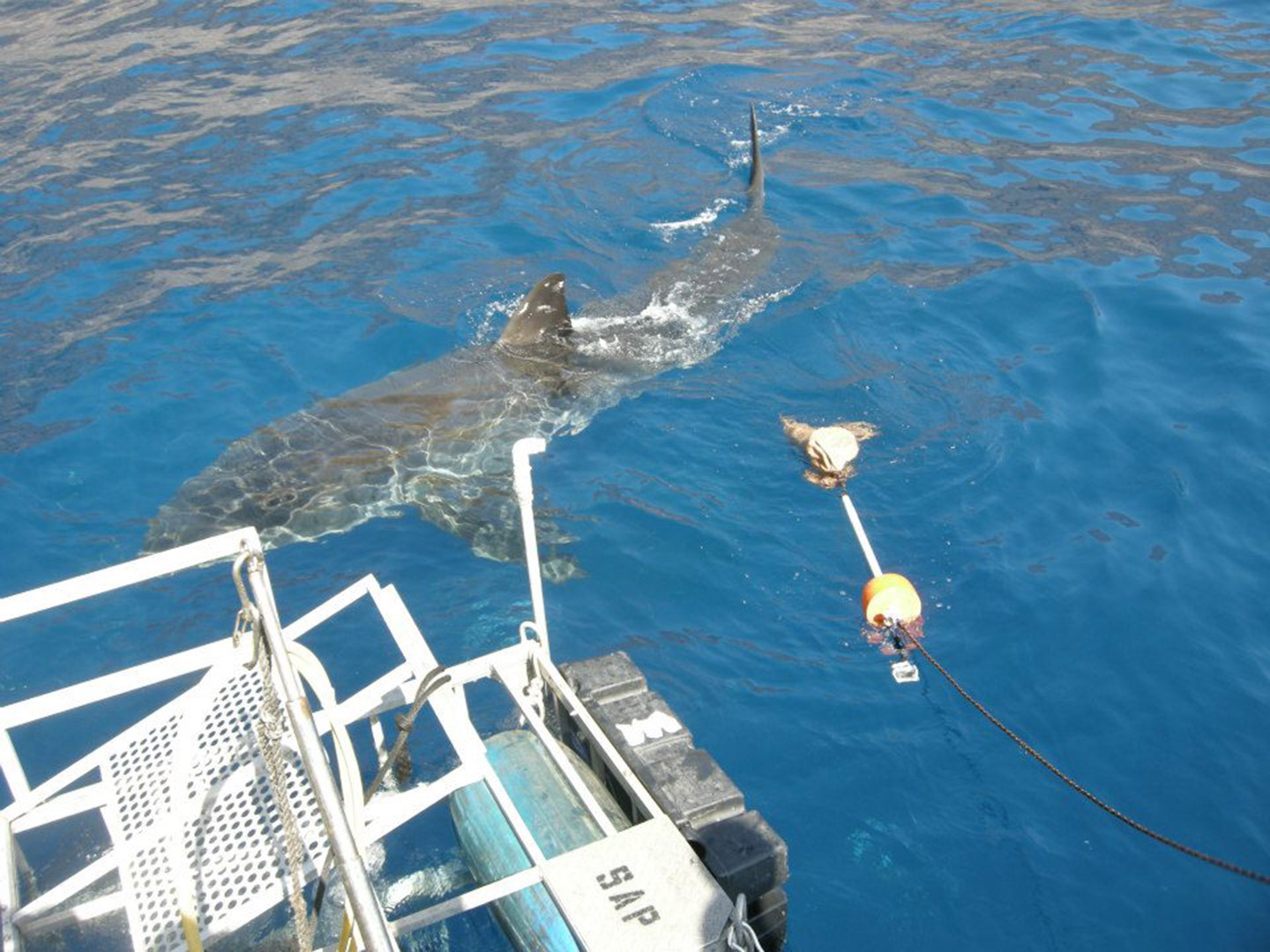
The cages float at the surface and the Shark Diver team is adamant that although other boats offer the “hanging cages” the surface is the best…and safest…place to view the sharks. Having been out with them on multiple trips, I agree. The water is 200 feet deep, crystal clear with up to 100-foot visibility. Our boat carries two cages; each holding four divers hooked up to an on-boat air supply. No scuba experience necessary. The water is 70 degrees, but wardrobe consists of a toasty five-millimeter wetsuit with hood and booties for the length of exposure. Divers rotate for one hour in the water all day long. Even if you’re chilly, you’ll want to get back in. Seeing whites in their habitat is not something that will ever get old…ever.
Nature has endowed these uber predators with flawless camouflage. How a 16-foot fish materializes out of nowhere is spine tingling and magical all wrapped into a perfect toothy package, and for a shark buff, it’s pure rapture. Their approach was not remotely sinister, but a very curious slow pass that brought us eye to eye with one of nature’s greatest predators. For the record, the term “dead eye of a shark” is dead wrong. The black pupil is rimmed by blue, and when the shark looks at you, you feel it. With each pass, you marvel at the streamlined physique, the scars each carries from shark-on-shark encounters and the catlike reflexes that maximize the wonder of something that large moving in silence. Size is pecking order and when the small ones suddenly vanish, an eerie pregnant silence settles in for a brief moment before some prehistoric behemoth rolls in for a closer look at the humans perched like canaries on display in a pet store.
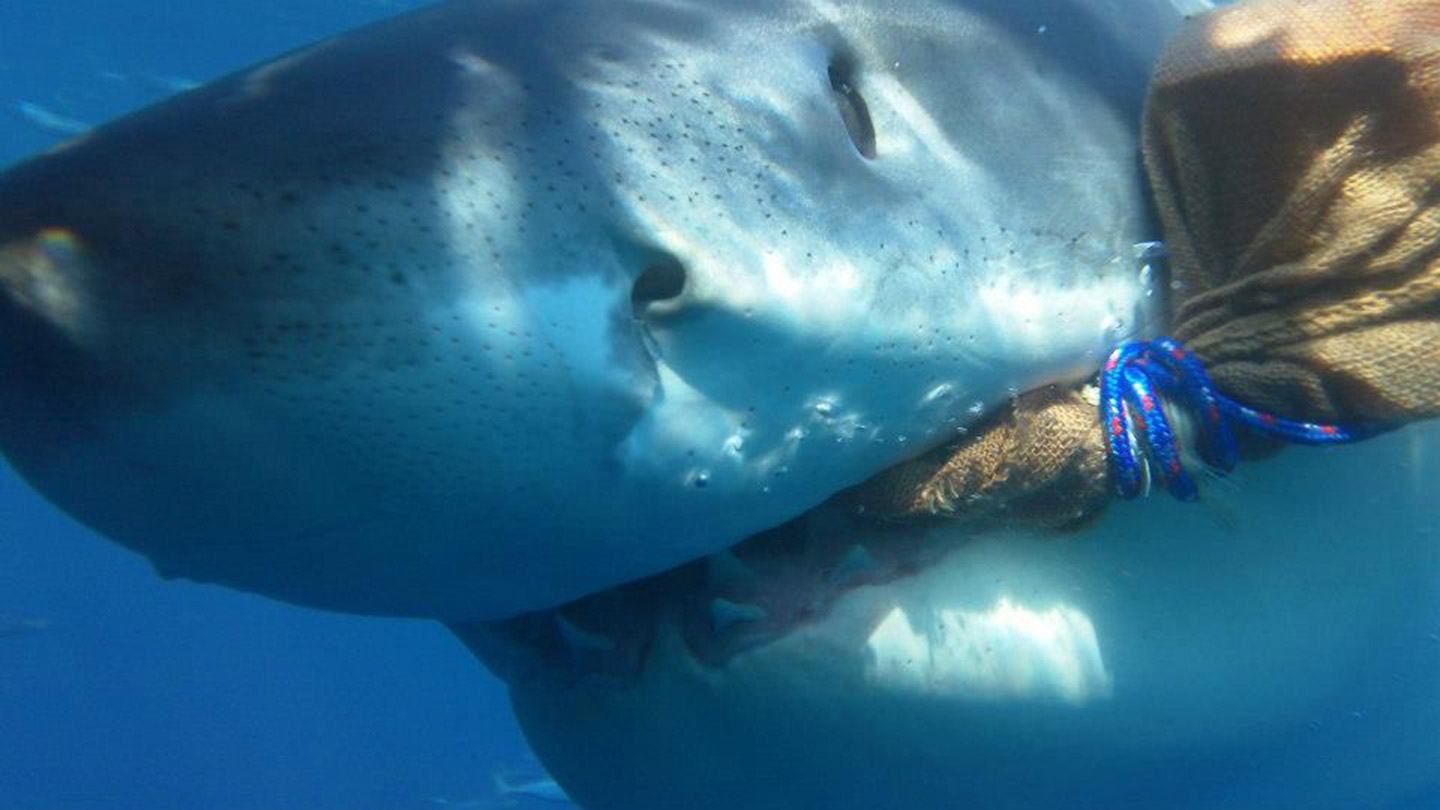
The sharks showed us nowhere near the curiosity we showed them. Because the island is a biosphere, feeding them is prohibited. The crew can only chum and use pull bait for attraction. The bags filled with an intoxicatingly putrid mix of fish guts and blood is why they come, not us. It allows for dramatic scenes when the shark commits to investigating, the jaw opens and extends and the animal goes for it. Sometimes the shark is faster than the crew and the bag makes its peace with God.
Between cage time we occupied ourselves downloading pictures, catching some sun on the deck and waiting to hear that dinner bell call…“Whitttteeeee Shark.” Apparently, a deckhand started the yell and it stuck. After the first day, we developed a Pavlovian response and came clamoring each time it rang out.
Evenings are for swapping stories and gleaning knowledge from shark experts. Lalo Saidy, in town for the season from his other shark diving gig in South Africa; or owner Martin Graf, a seasoned shark diver and conservation advocate, give a breakdown of sharks and behaviors from each day. On average, we saw seven or eight whites daily ranging in size from nine to eighteen feet. The team knows them by name. They know their personalities, their habits and how they got their scars. If you see a shark the crew hasn’t seen before, you get to name it. Make it good. No one knows exactly how long white sharks live but a rough estimate is 70 years.
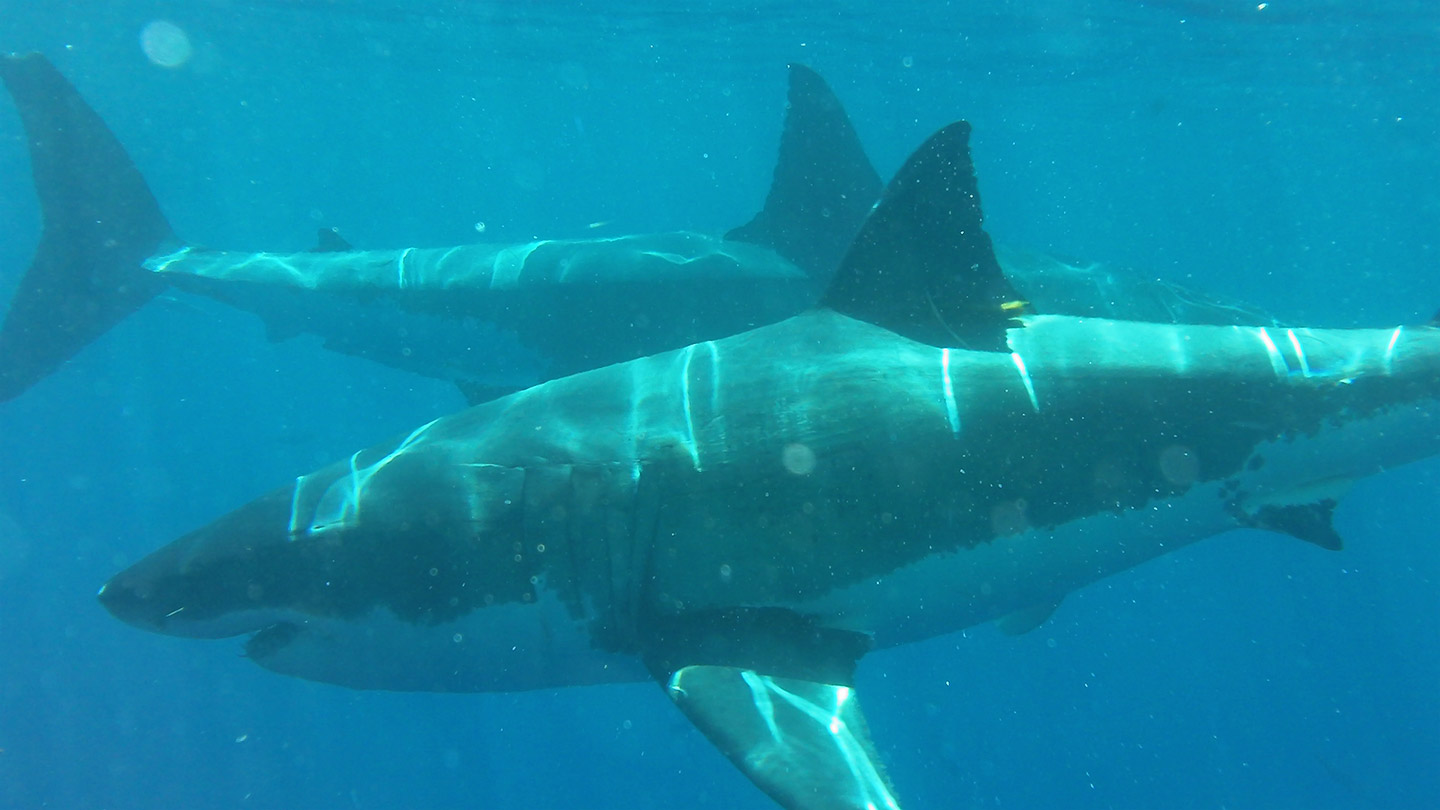
The season off Guadalupe runs from mid-August to early November with slightly smaller males, warmer water and calmer seas earlier and the biggest females showing up later with a bit more chance of a bouncy ride across the Pacific. That’s the trade off. My initial voyage with Shark Diver was the first trip of the season, and size was not a disappointment. The young males that populate Guadalupe’s waters in the summer are slightly smaller but more inquisitive and bold. You’ll get plenty of face time with them. Close enough to count the ampullae of Lorenzini on their noses, the sensory organs that register electrical impulses in the water. They’re hyper and active, going for the pull bait with Indy car speed and surgical precision. If the big girls are 18-footers, I didn’t miss the extra two feet.
My most recent trip was the last of the season, a perfect bookend. The conditions were a bit rougher but not by much. One day of swell had all of us, even the sea hardy marine biologists, popping Dramamine and going down for naps. Not news to anyone who has spent time at sea. It’s par for the course. The females were big, really big. Slower moving and deliberate in their approach as you might expect a submarine to be. They are less interested in the cages but still roll in for a glance here and there. Depending on the year, some of the younger males might still be around. If so, you get the best of both worlds.
How exactly does a place like Guadalupe become a mecca for white shark diving? By pure accident apparently. Our crew was a seasoned lot who have been making the shark trips for over 10 years. A few years before that they were a bunch of guys scuba diving and spear fishing the clear waters around the island. That is until they started encountering more and more white sharks. As the story goes, enough close encounters forced them to rethink their diving habits and became the inception of Shark Diver.
I’ve never much liked the term “trip of a lifetime.” It implies a climax to adventure. In the world of shark diving, this trip was just that.
Never one to sit still, Kinga Philipps has tested herself for the past decade by traveling the globe, rappelling, caving, scuba diving, jumping out of airplanes and diving with the sharks as a writer, producer and on-camera host. In her rare bits of free time, Kinga explores her singular fascination with sharks followed by a love for the beach, surfing, motorcycles, cars, charity work, travel, food and action sports.
This article was featured in the InsideHook newsletter. Sign up now.
